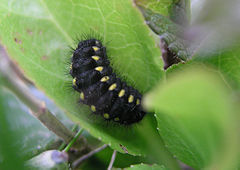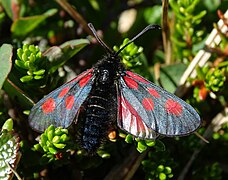
The six-spot burnet is a day-flying moth of the family Zygaenidae.

The Scotch argus is a butterfly of the family Nymphalidae. In spite of its English name argus, it is not a close relation of the brown argus nor the northern brown argus.

Zygaena transalpina is a moth of the family Zygaenidae.

Zygaena is a genus of moths in the family Zygaenidae. These brightly coloured, day-flying moths are native to the West Palearctic.

Zygaena carniolica, sometimes described as the crepuscular burnet or eastern burnet, is a member of the family Zygaenidae.

Zygaena ephialtes is day-flying species of burnet moth found in Europe. It is typically found in xeric habitats, and populations have recently decreased. It also exhibits Müllerian mimicry with other species, like Amata phegea.
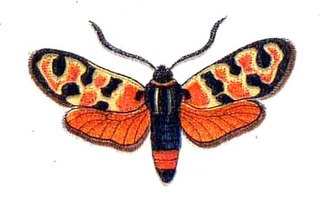
Zygaena fausta is a member of the family Zygaenidae, the day-flying burnet moths. Its bright aposematic colours of red, white and black on the wings indicate to possible predators such as birds that it is foul tasting or poisonous. In flight, the bright red abdomen is revealed, contrasting with the white legs and black head and antennae; the thorax is black and white with an eye spot on each side. There appears to be a considerable variation in pattern among specimens from different parts of Europe.
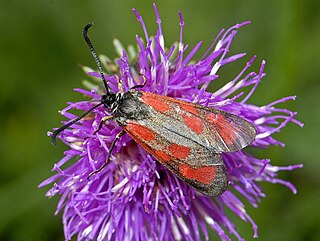
Zygaena loti, the slender Scotch burnet, is a moth of the family Zygaenidae. It is a diurnal moth characterized by a black body, light colored legs, and red spots on its wings. The caterpillars are a yellow-green color and usually molt out of dormancy in late February to early March. The larvae feed on plants from the family Fabaceae until they enter their pupal stage and mature into adults in May to early June. For mating, Zygaenidae exhibit a dual-partner finding strategy, where females use pheromones while assuming a calling position, and males exhibit a patrolling behavior where they utilize both vision and the olfactory receptors in their antennae to locate a potential mate.
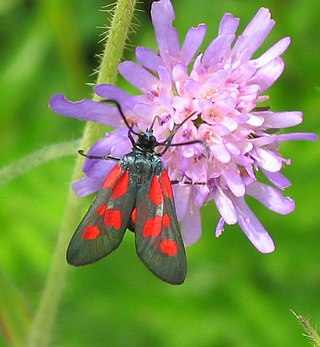
Zygaena viciae, the New Forest burnet moth, is a member of the Zygaenidae family, found in the northern hemisphere. Since 1927 it has been extinct in the New Forest, England, after which it is named. It is also known in Europe as the small five-spotted ram.
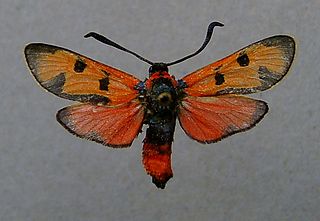
Zygaena laeta, the bloodword burnet, is a moth of the family Zygaenidae. It is found in Central and South-Eastern Europe.In Z. laeta the collar and patagia as well as the apical half of the abdomen are red: also the wings are testaceous red except some black spots on the forewing. Larva of light bluish green, with while dorsal and lateral lines, along which there are blackdots. Pupa yellow, anteriorly dark brown, in a whitish cocoon. The wingspan is 26–34 mm.

Zygaena lonicerae, the narrow-bordered five-spot burnet, is a moth of the family Zygaenidae. The species was first described by Theodor Gottlieb von Scheven in 1777.

Zygaena purpuralis, the transparent burnet, is a moth of the family Zygaenidae.

Zygaena occitanica, the Provence burnet, is a moth of the Zygaenidae family. It is found from the Algarve and southern Spain up to the eastern parts of the Cantabrian Mountains then to southern Russia and the Caucasus and east to the western fringe of Central Asia.

Zygaena osterodensis is a moth of the family Zygaenidae.

Zygaena sarpedon is a moth of the Zygaenidae family. It is found in France, Italy and on the Iberian Peninsula.

Zygaena hilaris is a species of moth in the family Zygaenidae.

Zygaena cynarae is a species of moth in the Zygaenidae family. It is found from France east to Russia.

Zygaena erythrus, common name sluggish burnet, is a species of moth in the family Zygaenidae.

Zygaena angelicae is a species of moth in the Zygaenidae family. It is found in Central Europe, from Greece to southern Germany and Thuringia. Z.angelicae has blue-black or green-black forewings, whose inner angles are strongly rounded off. On the forewings there are five or six red spots, two of which are always close together. In the five-spotted individuals, the spots on the underside of the wings are connected by a red stripe, in the six-spotted ones this is a large patch. The black margin of the red hind wings is wide. The antennal club is white at the tip less so than in Zygaena transalpina and the white may be completely absent. The wingspan is 30–33 mm.

Zygaena rhadamanthus is a species of moth in the Zygaenidae family. It is found in France, Spain, Portugal and Italy.

